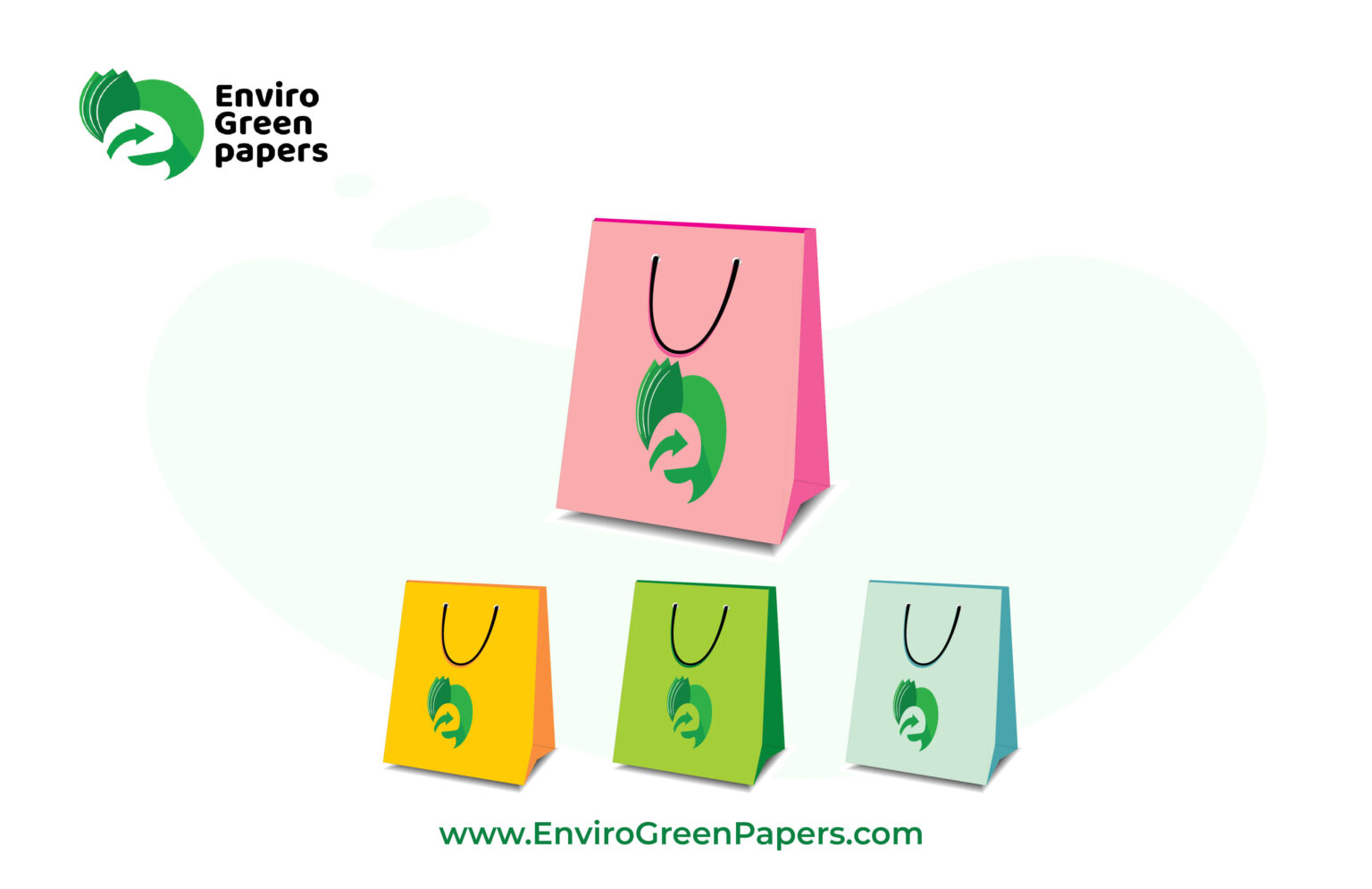In recent years, global awareness of environmental issues has led to a significant shift in consumer behavior and a growing demand for sustainable alternatives to traditional packaging materials. One such alternative that has gained popularity is paper bags.With concerns over plastic pollution and the desire to make more eco-friendly choices, many businesses and individuals are considering paper bags for food packaging.
In this article, we will explore the suitability of paper bags for food packaging, considering their environmental impact, food safety considerations, consumer perception, and more.
In the wake of increasing environmental consciousness and the need for sustainable packaging solutions, paper bags have emerged as a popular choice for businesses in India. Enviro Green Papers stands out as a leading player among the industry’s reputable manufacturers.
Enviro Green Papers has established itself as a reliable and innovative paper bag manufacturer in India with a commitment to eco-friendly practices and high-quality products. In this article, we will delve into the capabilities and offerings of Enviro Green Papers, highlighting their contributions to sustainable packaging and their commitment to meeting the diverse needs of businesses nationwide.
The Environmental Impact of Plastic Bags
Plastic Pollution
Plastic bags have long been a significant contributor to environmental pollution. They take hundreds of years to decompose, and during that time, they accumulate in landfills and oceans, posing a significant threat to wildlife and ecosystems.
Plastic pollution has become a pressing global issue, with devastating consequences for marine life and the environment.
Harm to Wildlife
Marine animals often mistake plastic bags for food, leading to ingestion and entanglement, which can be fatal. Additionally, microplastics from the degradation of plastic bags enter the food chain, potentially harming marine and terrestrial species, including humans.
Non-Biodegradable Nature
Plastic bags are made from petroleum-based materials that are non-biodegradable. This means that even when they break down, they only fragment into smaller pieces, known as microplastics, which remain in the environment indefinitely.
Rise of Paper Bags as an Alternative
With the growing concerns surrounding plastic bags, paper bags have emerged as a sustainable alternative for packaging various products, including food. Let’s explore why paper bags are becoming popular and their advantages.
Advantages of Paper Bags
Paper bags offer several advantages over their plastic counterparts. Firstly, they are made from a renewable resource – trees. This makes them more sustainable compared to plastic bags derived from fossil fuels. Furthermore, paper bags are recyclable and contribute to the circular economy when adequately disposed of.
Sustainable Material
The production of paper bags involves fewer harmful emissions than plastic bag manufacturing, further reducing their environmental impact. Additionally, using responsibly sourced and certified paper ensures the sustainability of the raw materials.
Biodegradable and Compostable
Unlike plastic bags, paper bags are biodegradable and compostable. They break down naturally over time, returning to the earth without leaving behind harmful residue or microplastics.
Strength and Durability
Modern advancements in manufacturing techniques have produced more robust and durable paper bags. Reinforced handles and improved designs allow paper bags to carry heavier loads and withstand rough handling, making them suitable for food packaging.
Food Safety Considerations
When it comes to food packaging, safety, and hygiene are of paramount importance. Paper bags must meet specific criteria to ensure they are suitable for packaging food items securely. Let’s delve into the key considerations.
Regulation and Standards
Government regulations and industry standards govern using paper bags for food packaging. These regulations outline the requirements for materials, ink, and adhesives used in paper bag production to prevent contamination and ensure food safety.
Barrier Properties
Paper bags designed for food packaging often incorporate additional barrier properties to protect the contents from moisture, grease, and oxygen. Coatings, laminations, or specialized paper grades enhance these properties, maintaining the quality and freshness of the packaged food.
Storage and Transportation
The suitability of paper bags for food packaging also depends on their performance during storage and transportation. They should be able to withstand temperature variations, humidity, and physical stress to ensure the safe delivery of food items to consumers.
Paper Bags in the Food Industry
As businesses in the food industry strive to adopt more sustainable practices, paper bags have found their place in various segments. Let’s explore the different applications of paper bags in the food industry.
Restaurants and Cafes
Many restaurants and cafes have started offering paper bags for takeout orders. These bags provide a more eco-friendly alternative to plastic or Styrofoam containers, allowing customers to enjoy their meals while minimizing their environmental impact.
Grocery Stores
Paper bags have become a common choice at grocery stores, offering customers a sustainable option for carrying their groceries. Some stores even incentivize the use of paper bags by providing discounts or rewards to shoppers who bring their own.
Takeout and Delivery Services
In the era of food delivery apps, paper bags have become a popular choice for packaging takeout meals. They provide a convenient and eco-friendly way to transport food, ensuring it remains fresh and intact during delivery.
Consumer Perception and Branding
The choice of packaging can significantly influence consumer perception and brand image. With their eco-friendly appeal, paper bags can contribute to a positive brand image and resonate with environmentally conscious consumers.
Eco-Friendly Image
Using paper bags for food packaging aligns with consumers’ increasing environmental awareness and preference for sustainable options. It portrays businesses as responsible and environmentally conscious, which can attract and retain customers who prioritize eco-friendly choices.
Customer Preferences
Surveys and studies indicate that many consumers prefer businesses that use sustainable packaging materials. Companies can cater to these preferences by opting for paper bags and differentiating themselves in the market.
Cost and Affordability
When considering any packaging option, the cost is essential for businesses and consumers. Let’s explore the cost aspects associated with paper bags.
Production Costs
The production costs of paper bags vary depending on factors such as size, design complexity, and customization. While they may be slightly higher than plastic bags, the prices have become more competitive as demand for sustainable packaging solutions has increased.
Pricing for Businesses and Consumers
The pricing of products packaged in paper bags may reflect the additional cost of eco-friendly packaging materials. However, it is essential to note that the cost difference is often minimal and can be offset by the positive impact on brand reputation and customer satisfaction.
Challenges and Limitations
Although paper bags offer many advantages, they also have specific challenges and limitations that must be considered.
Moisture and Grease Resistance
One of the primary limitations of paper bags is their susceptibility to moisture and grease. While advancements have enhanced their resistance, prolonged exposure to liquids or oily food items can compromise the bag’s integrity.
This is why specialized coatings or liners are sometimes added to improve resistance.
Limited Reusability
Compared to reusable alternatives like cloth bags, paper bags have limited reusability due to their susceptibility to wear and tear.
Recycling and Waste Management
Proper recycling and waste management systems are crucial to maximize the environmental benefits of paper bags. Paper bags should be recycled in designated recycling bins to ensure the paper fibers can be reused to produce new products.
Awareness and education regarding the correct disposal and recycling of paper bags are essential to promote responsible waste management.
Innovations and Future Trends
The continuous development of technology and materials offers exciting possibilities for the future of paper bags and sustainable packaging. Here are a few innovations and trends to watch out for:
Coating Technologies
Advancements in coating technologies have resulted in the development of water-resistant and grease-resistant coatings for paper bags. These coatings can significantly enhance the bag’s performance, making them more suitable for a broader range of food items.
Composite Materials
Composite materials that combine paper with other renewable or biodegradable materials are being explored to improve paper bags’ strength, durability, and barrier properties. These innovations aim to provide sustainable packaging solutions without compromising functionality.
Circular Economy Approach
The concept of a circular economy, which focuses on reducing waste and maximizing resource efficiency, is gaining traction in the packaging industry.
Conclusion
Paper bags have emerged as a viable and sustainable alternative for food packaging. They address the environmental concerns associated with plastic bags with their eco-friendly appeal, recyclability, and biodegradability. While they have certain limitations, advancements in technology and materials are continuously improving their performance.
Paper bags meet the demands of environmentally conscious consumers and contribute to positive brand image and customer satisfaction.As the world continues to prioritize sustainability, paper bags are likely to play a significant role in the future of food packaging.
FAQs
Are paper bags safe for packaging food items?
Yes, paper bags can be safe for packaging food items. However, ensuring that the paper bags used meet regulatory standards for food contact materials and have appropriate barrier properties to maintain food safety and quality is essential.
Can paper bags be reused?
While paper bags have limited reusability due to their susceptibility to wear and tear, but they can still be reused for lighter items or storage bags.Remember to check the bag’s condition before reuse and recycle it when it becomes damaged or worn out.
Are paper bags more expensive than plastic bags?
The cost of paper bags may be slightly higher than plastic bags due to factors such as production and material costs.
However, the price difference is often minimal and can be justified by the positive environmental impact and customer preference for sustainable packaging options.
How should paper bags be disposed of after use?
Paper bags should be disposed of in designated recycling bins to ensure they are recycled properly.
Can paper bags be used for hot or greasy food items?
While paper bags can handle a certain level of heat and grease, it is advisable to use specialized paper bags with appropriate coatings or liners for hot or greasy food items.
These additional measures enhance the bag’s resistance and prevent potential leaks or oil stains.
Remember, when considering paper bags for food packaging, always prioritize food safety, regulatory compliance, and the specific requirements of your business or industry.
Visit us : buzziova



